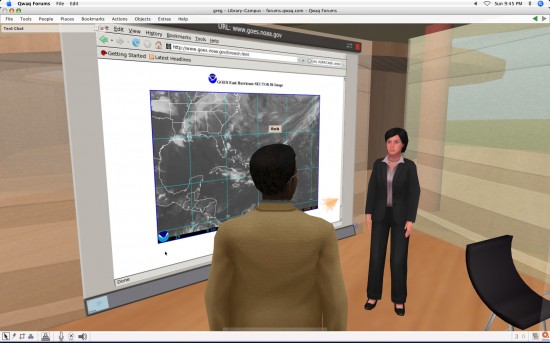Earlier this week, Teleplace announced that it was releasing the current version of proprietary virtual world software to the open source community as OpenQwaq. The next generation of its software won’t be commercially available for three to six months.
The Teleplace software normally runs for $50 per user per month for the hosted version and $100 per user per month for the on-premises software — and the company says it has hundreds of corporate clients with “thousands” of users.
Did Teleplace just shoot itself in its profitable foot?
Not according to company CEO Tony Nemelka.
Grow the market

The idea isn’t to destroy the company’s business model, but to grow the market, Nemelka told Hypergrid Business.
First of all, existing Teleplace customers aren’t likely to flee to OpenQwaq, he said. With the paid subscription, they get full support, and an automatic upgrade to the next generation of Teleplace, Teleplace Connect, once that comes out. (See related story here.) In addition, most Teleplace customers use the hosted version of the software, said Nemelka. With a subscription, the hosting is part of the package.
But the bigger issue, he said, is that the platform isn’t being used as much as it should be.
“Not enough people are exposed to the technology,” he said. “We felt that there was an obligation we had, to expose a lot more people to the technology.”
The open source release of the platform will do “no economic harm to us and will benefit the market as a whole,” he added.
“What we’re trying to get is much broader adoption of this type of technology,” he said. “We will continue, with OpenQwaq, to expand our community of users. It’s definitely not a shift in our target market focus, but it definitely is an opening up and engagement with a broader community, including universities, and may represent people who are not ready to invest now, but may be ready to invest over time.”
How open is OpenQwaq?
The only difference between OpenQwaq and the current version of Teleplace is that OpenQwaq is missing the proprietary, licensed video codex.
“We couldn’t include that in the open source project,” said Nemelka. “But we have included instructions about how to license it and add it to the implementation. Otherwise, it’s no different in any way from what a customer would have procured a week ago.”
OpenQwaq includes both the Teleplace server software and the stand-alone, downloadable viewer. Both are released under GPL-2. This means that any derivative work will also have to be open sourced.
That doesn’t mean that other companies won’t be able to profit from OpenQwaq, Nemelka said.
For example, any hosting company currently offering OpenSim, RealXtend or OpenWonderland environments can also offer OpenQwaq virtual environments to their customers.
“Outside vendors can download it and host environments,” he said, “but can’t resell modifications for commercial gain.”
In addition, hosting providers will have to license the video codex separately, he added.
By comparison, the OpenSim server software is released under the BSD license, which allows vendors to create derivative works, keep them proprietary, and profit from them. RealXtend, a mesh-enabled branch of OpenSim that’s been rebuilt from the ground up as a game development platform, is released under the Apache 2 license, which also allows proprietary works. OpenWonderland, a Java-based virtual world platform originally launched by Sun but spun off after the acquisition by Oracle, is licensed under GPL 2 with a “Classpath” exception, allowing vendors to distribute proprietary add-on modules.
The original technology behind Teleplace — and OpenQwaq — was Open Croquet. It was a basic tool set, not a complete virtual world platform, and it was distributed under the MIT license — which permits reuse in proprietary applications. Teleplace was a virtual world platform built on top of the Open Croquet components. Open Croquet itself hasn’t been seeing much action, however, with most development work having moved over to Open Cobalt, a complete open source virtual world platform built on top of Croquet.  Like Open Wonderland, Open Cobalt has had difficulty getting traction with users, with occasional deployments in university programming classes. Open Cobalt is also distributed under the MIT license, which will hinder collaboration between its developers and those working in OpenQwaq.
How good is it?
Teleplace is one of the top enterprise-class virtual world platforms out there. The other big ones are ProtoSphere, which, like Teleplace, runs behind the firewall, and Web.alive, which runs in the browser.
Teleplace fully supports Collada mesh imports as well as other mesh standards, integrates with Microsoft Sharepoint, and allows in-world application sharing.
The platform also offers robust security features and integration with corporate directories. Like all the other enterprise-class platform, virtual land is not laid out in regions on a grid — as with Second Life and OpenSim — but in rooms, where any room can be connected to any other room via a teleportation portal. A room can be as large as a server can handle, however — as large as an entire city block — and sky and clouds can be painted on the walls to give the appearance of an outdoor campus. A virtual world can be composed of an unlimited number of linked rooms.
These are standard features of enterprise-grade immersive virtual environments.
Where Teleplace differs from other platforms is in its variety of in-world building tools. Users who want to change the virtual environment — and have the permissions to do so — aren’t limited to using content created by professionals in 3D modeling programs. They can also make simple objects right inside the environment, arrange existing objects, stretch them, apply textures, or group them.
Another difference is that Teleplace avatars have personal inventories. That means users can upload documents, for example, carry them from one virtual meeting room to another, and share them with other users.
All this functionality is now available for free, with the OpenQwaq software.

However, while Teleplace is a good fit for, say, geographically distributed engineering teams looking for a virtual collaboration platform, it is not a virtual world platform in the sense that Second Life or OpenSim are.
There is no in-world currency support, for example, and limited avatar options or animations. And there is — yet — no third-party marketplace of avatar clothing, accessories, virtual pets, castles, and all the other stuff that makes a world a world.
As a result, OpenQwaq is not a platform to choose if you’re looking to create a commercial virtual world like Second Life, InWorldz, or Avination.
Finally, neither Teleplace nor OpenQwaq are hypergrid-enabled. Teleportation is only possible between rooms running in the same virtual environment. If my company has a Teleplace world, and your company has a Teleplace world, I can’t take my avatar and teleport from my virtual office to yours.
This is currently possible in OpenSim, if both grids are hypergrid-enabled. Cross-world teleports are also a feature of Open Cobalt.
“That was never a requirement that any of our customers had,” said Nemelka. “Technology, it’s possible to enable that, and I can imagine the OpenQwaq community exposing more of that capability as participants in that community see a need for it.”
To join the OpenQwaq community, people can visit the project’s website — where they can also download the software — or the project’s Google Group. Nemelka said he was surprised to see unfamiliar names signing up – including folks interested in related projects such as Smalltalk, Squeak, and Croquet.
However, Teleplace isn’t planning on outsourcing future feature development to the open source community.
“We’re not doing this because we ran out of engineering resources,” said Nemelka. In fact, because of the licensing of OpenQwaq, Teleplace can continue to donate code to the project — but cannot take code back out to use in its own proprietary software.
In fact, the company plans to donate more to OpenQwaq, including some of the new features of Teleplace Connect.
“We will continue to contribute to the ongoing development of OpenQwaq,” he said. “We view ourselves as the primary sponsor of it.”
- OpenSim user growth cools down with chilly weather - November 15, 2024
- Kitely adds PBR materials support, larger textures - November 8, 2024
- OSCC 2024 Submission Deadline Approaching - October 19, 2024
